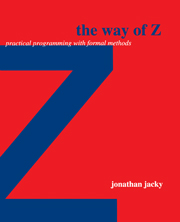Book contents
- Frontmatter
- Contents
- Preface
- I Why Z?
- II Introducing Z
- 4 What is Z?
- 5 A first example in Z
- 6 From prose to Z: control console
- 7 Introducing schemas: text editor
- Further reading
- III Elements of Z
- IV Studies in Z
- V Programming with Z
- Further reading
- A Glossary of Z notation
- B Omitted features
- C Operator precedence
- D The Z mathematical tool-kit
- E Selected Laws
- F Solutions to selected exercises
- G Other formal notations
- Bibliography
- Index
4 - What is Z?
Published online by Cambridge University Press: 06 July 2010
- Frontmatter
- Contents
- Preface
- I Why Z?
- II Introducing Z
- 4 What is Z?
- 5 A first example in Z
- 6 From prose to Z: control console
- 7 Introducing schemas: text editor
- Further reading
- III Elements of Z
- IV Studies in Z
- V Programming with Z
- Further reading
- A Glossary of Z notation
- B Omitted features
- C Operator precedence
- D The Z mathematical tool-kit
- E Selected Laws
- F Solutions to selected exercises
- G Other formal notations
- Bibliography
- Index
Summary
Z is a set of conventions for presenting mathematical text, chosen to make it convenient to use simple mathematics to describe computing systems. I say computing systems because Z has been used to model hardware as well as software.
Z is a mature notation. Conceived in the late 1970s, it developed through the 1980s in collaborative projects between Oxford University and industrial partners, including IBM and Inmos (a semiconductor producer). The first Z reference manual to be widely published benefited from this long experience when it finally appeared in 1989. At this writing a draft Z standard (including a formal semantics) is being considered by the American National Standards Institute (ANSI), the British Standards Institute (BSI) and the International Organization for Standardization (ISO). Z has served as the basis for other notations, including several variants adapted for object-oriented programming.
Z is a model-based notation. In Z you usually model a system by representing its state — a collection of state variables and their values — and some operations that can change its state. A model that is characterized by the operations it describes is called an abstract data type (ADT). This modelling style is a good match to imperative, procedural programming languages that provide a rich collection of data types, and also to some physical systems (such as digital electronics) that include storage elements. Z is also a natural fit to object-oriented programming.
- Type
- Chapter
- Information
- The Way of ZPractical Programming with Formal Methods, pp. 31 - 32Publisher: Cambridge University PressPrint publication year: 1996

